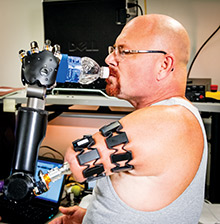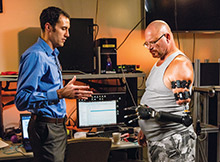Undergoing osseointegration surgery has allowed an individual with a transhumeral amputation, Johnny Matheny, to attach the Modular Prosthetic Limb (MPL), developed by the Johns Hopkins University (JHU) Applied Physics Laboratory (APL), directly to his residual limb. This has enabled Matheny to achieve a greater range of motion and comfort than previously possible. This is a first for the field of prosthetics, said Michael McLoughlin, chief engineer in APL’s Research and Exploratory Development Department (REDD).

Matheny demonstrates his ability to grasp a water bottle. Photographs courtesy of Johns Hopkins University Applied Physics Laboratory.
Matheny, whose left arm was amputated in 2008 because of cancer, is one of several patients who have worked with the MPL over the years to help scientists, engineers, and physicians fine-tune its capabilities and test its usability. He was the first patient at The Johns Hopkins Hospital, Baltimore, Maryland, to undergo targeted muscle reinnervation (TMR), a surgical procedure that reassigns nerves that once controlled the arm or hand, which can make it possible for people with upper-limb amputations to better use and control an advanced prosthetic device.
Richard McGough III, MD, chief of the Division of Musculoskeletal Oncology at the University of Pittsburgh Medical Center, performed the first of the two-stage osseointegration surgery on Matheny in March 2015. First, a custom-made compressive device, called Compress®, was implanted into the marrow space of the bone of the residual limb. This bone-anchoring device induced a biological response from the bone to create a strong, long-lasting connection between the implant and the bone. McGough performed stage two in June 2015, at which time an adaptor brought through the skin was connected to the implant on the bone side, enabling a direct connection to the external prosthesis. Four months later, Matheny traveled to APL and the MPL was attached directly to his body, via the abutment, for the first time, making Matheny the first patient in the United States to receive TMR and osseointegration.
“Before, the only way I could put the prosthetic on was by this harness with suction and straps…,” said Matheny. “It’s all natural now. Nothing is holding me down. Before, I had limited range; I couldn’t reach over my head and behind my back. Now boom, that limitation is gone.”

Matheny tests his range of motion with the osseointegrated MPL.
Over the course of three days, Matheny went through a series of exercises in APL’s prosthetics laboratory to determine the limits of his newfound control and range of motion. “What he’s been able to do without that socket interface has been unbelievable,” said Courtney Moran, a clinical prosthetist at the APL’s REDD.
Moran said she and her team initially tempered their expectations about what Matheny would be able to accomplish. However, Matheny had been doing exercises on his own, so he met all of her planned goals within two hours of arriving, she said. For the rest of the visit, they challenged his ability, she said, and Matheny was able to demonstrate individual finger control, simultaneous finger control, two degrees of freedom at the wrist, and multiple grasps, and also worked through simulated activities of daily living.
“The challenge for us next is to really figure out how to get this technology out of the laboratory and into the hands of people who need it,” said McLoughlin.
Editor’s note: This story was adapted from materials provided by Johns Hopkins University Applied Physics Laboratory.




